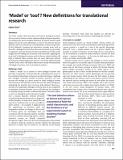‘Model’ or ‘tool’? New definitions for translational research
Author(s)
Sive, Hazel
DownloadSive_Model or.pdf (72.48Kb)
PUBLISHER_CC
Publisher with Creative Commons License
Creative Commons Attribution
Terms of use
Metadata
Show full item recordAbstract
The term ‘model’ often describes non-human biological systems that are used to obtain a better understanding of human disorders. According to the most stringent definition, an animal ‘model’ would display exactly the same phenotype as seen in the relevant human disorder; however, this precise correspondence is often not present. In this Editorial, I propose the alternative, broader term ‘tool’ to describe a biological system that does not obviously (or precisely) recapitulate a human disorder, but that nonetheless provides useful insight into the etiology or treatment of that disorder. Applying the term ‘tool’ to biological systems used in disease-related studies will help to identify those systems that can most effectively address mechanisms underlying human disease. Conversely, differentiating ‘models’ from ‘tools’ will help to define more clearly the limitations of biological systems used in preclinical analyses.
Date issued
2011-03Department
Massachusetts Institute of Technology. School of Science; Whitehead Institute for Biomedical ResearchJournal
Disease Models and Mechanisms
Publisher
Company of Biologists, The
Citation
Sive, H. “‘Model’ or ‘Tool’? New Definitions for Translational Research.” Disease Models & Mechanisms 4.2 (2011): 137–138.
Version: Final published version
ISSN
1754-8403
1754-8411